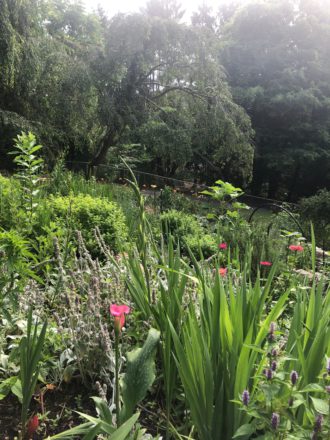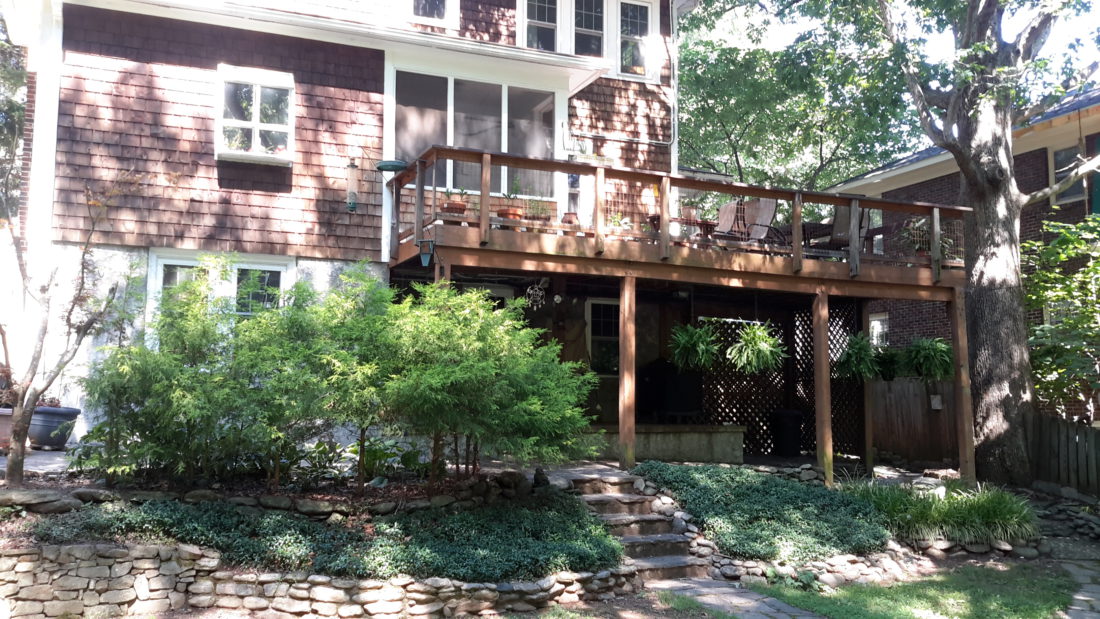Watering thirsty exotic plants and trying everything short of Agent Orange to get rid of weeds are familiar struggles for many gardeners — much to the chagrin of anyone concerned about the effects of chemical pesticides, invasive species or habitat loss.
But Phyllis Stiles, who founded Bee City USA in Asheville in 2012 before the organization’s 2018 merger with the Portland, Ore.-based Xerces Society for Invertebrate Conservation, says attitudes are shifting in favor of a more environmentally sustainable approach. Wildlife-friendly gardening, she says, is in.
“More and more nurseries are emphasizing it,” Stiles says. “The garden clubs are emphasizing it more; the master gardeners are emphasizing it more.”
The trend has certainly caught on in Asheville, which last year joined only seven other cities in North Carolina to earn recognition from the National Wildlife Federation as a certified Community Wildlife Habitat.
Since 1973, the NWF has managed a certification program for individual yards and gardens, but the Community Wildlife Habitat effort, established in 1997, honors cities and towns that have reached a critical mass of wildlife-friendly landscapes. As of 2018, Asheville had over 280 homes, seven schools, two churches and 10 communal spaces certified with the help of local volunteers and organizations.
All these certifications have made a difference for local wildlife. They’ve also grabbed the attention of one rather surprising species in particular: the Greater North American Curious Neighbor.
“I get people that come by the back all the time and stop and look and compliment me on it,” says Randy Marrs about his property in North Asheville. “I’ve had several people that saw the wildlife sign, and they asked me how they could get their property designated as a wildlife area.”
Do it yourself
Although planting a wildlife-friendly garden may require some elbow grease, getting it certified is “very easy,” says Marrs. Those interested in certification need only make sure their property meets the requirements listed on the NWF’s online checklists, available at avl.mx/6ae.

The physical Certified Wildlife Habitat requirements are relatively simple: three types of food source, a water source, two types of shelter and two places for wildlife to mate and raise young. Applicants can pick from several options under each category, including easy backyard additions, to fit their personal style. Plants with edible seeds count as food sources, for example; a bird bath can fulfill the water requirement, while a bat house counts as shelter.
Kit Schmeiser, the president of local NWF chapter Mountain Wild!, uses a bird feeder, a small pond and a few trees to meet those requirements in her own yard. She is particularly proud of the habitat her pond provides: “We have a frog who has taken up residence there,” she says.
Certification also calls for applicants to employ sustainable techniques from at least two of three categories: soil and water conservation, controlling exotic species and organic practices. Mulching, rain barrels and terraces all qualify — and can be worked into a stylish garden layout.
Those changes, Marrs says, make a home’s habitat more attractive to the human species as well. “When I moved here, there was nothing. There were no trees, no plants, absolutely nothing,” he recalls. Adding flowers and trees with wildlife in mind, he says, “turned it into a really nice area.”
Marrs thinks the wildlife-friendly alterations to his own yard may help him sell his house someday. “What I’ve done, everything in the back, that’s going to be one of the selling points, and the fact that the property is a wildlife-certified property,” he says.
Going native
One practice that defines Stiles’ style is the use of native plant species. When laying out a landscape, she says, employing those species keeps her “looking at your yard through the eyes of the animals you want to attract.”
In some cases, that perspective requires a reworking of style expectations. “You might step out in your yard and say, ‘Oh great, there’s no holes in my plants, no bugs.’ That’s the problem,” Stiles says. “Bugs eat bugs, and everything else eats bugs, and so if you don’t have bugs in your yard, then you’re not supporting wildlife.”
Many organisms have evolved together and rely heavily on one another, such as monarch butterflies and their milkweed food source. Although many non-native species are popular because they grow quickly and may initially be easier to take care of, Stiles says, native plants are often more resilient because they are better adapted to local conditions.
The NWF’s website has suggestions for native plants that can help round out a certified yard or garden habitat, and local nonprofit Asheville GreenWorks also lists native plants that are good for pollinators. Some examples from the GreenWorks list include dogwood trees, known for their pretty blooms, and Dutchman’s pipe, a unique vine with broad leaves and pipe-shaped green and purple flowers.
Likewise, Schmeiser also supports planting native. “It’s a win-win for the gardener and a win-win for the wildlife,” she says. Not only are native plants more likely to attract wildlife, she points out, they are also more drought- and pest-resistant.
Ways of the wild
Schmeiser and her husband, Stephen, a past president of Mountain WILD!, have a few more tips for turning yards into stylish, first-class habitat. For example, the couple advocates planting perennials, which bloom year after year, rather than annuals, which need to be replaced yearly — a measure that saves time and money and ensures a more consistent habitat for wildlife. Suitable perennials for the Asheville area include wild bergamot, which has light-purple blooms, and bright yellow black-eyed Susans.
To make sure the wildlife benefits don’t fade after spring and summer, Stephen advocates choosing a variety of plants that bloom throughout the year, providing consistent habitat and food. A sample garden might include spring-blooming spiderwort, summer-flowering phlox and Canada goldenrod, which blooms in the fall.
When it comes to managing existing grass, “mowing tall” can protect many organisms, such as bugs or earthworms, that live underground or very low to the ground. The Schmeisers say mowing grass as high as possible — or less often — is especially helpful for fireflies, which sleep in the grass when not flying around at night.
Above grass level, Stephen recommends a technique called “islanding” as a method of adding vertical interest to a yard or garden. Flowers, shrubs or trees can be planted in small groups throughout a space, rather than only around the edges, to create a healthier and more varied habitat.
The Schmeisers also recommend using natural fertilizers, such as a compost pile or manure, over artificial fertilizers, which may leach into water sources and cause problems for surrounding ecosystems. The same goes for pesticides, which include herbicides such as Roundup, insecticides and fungicides. Stephen says these chemicals often kill many more species than the one or two a gardener hopes to eliminate.
A much gentler mixture of water, vinegar, Dawn detergent and Epsom salt, says Kit, can be used in moderation as a weed killer on sunny days, when its effects are enhanced by the sun’s ability to dry plants out. For pests, one natural approach is to fight fire with fire: “Snakes are good,” she says.
Wildlife faces many challenges. “Climate change, habitat loss, pesticides — you put it all together and you’ve got a perfect storm,” Stiles says. But with habitat certification, landowners can help the wild fight back, one backyard at a time.




I am so interested in all you have to help the environment!